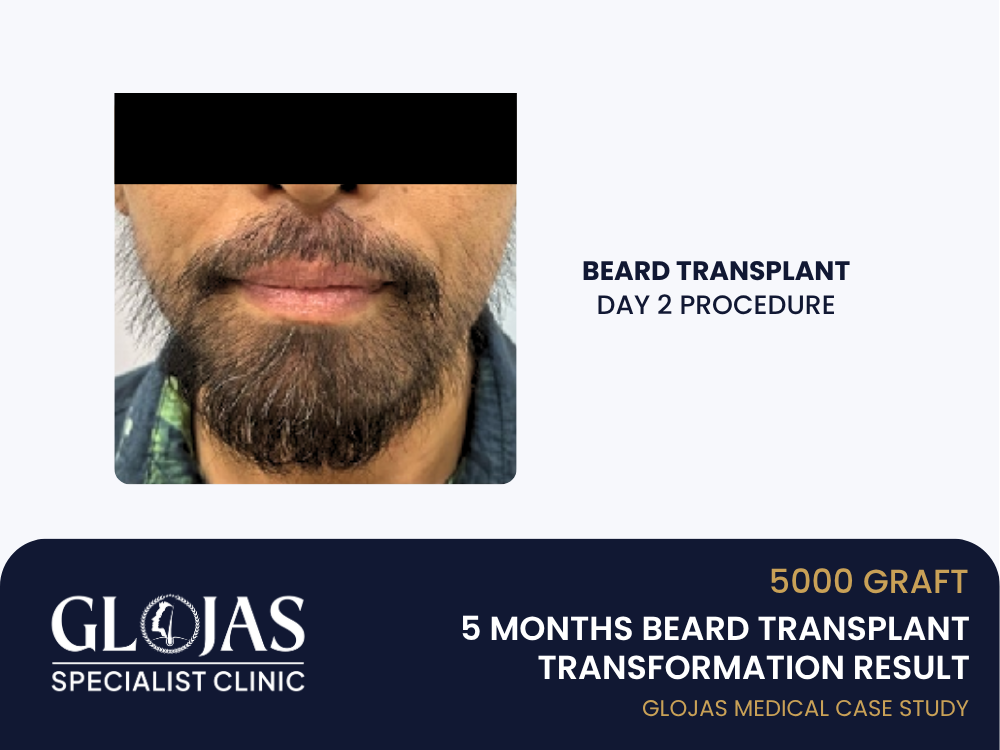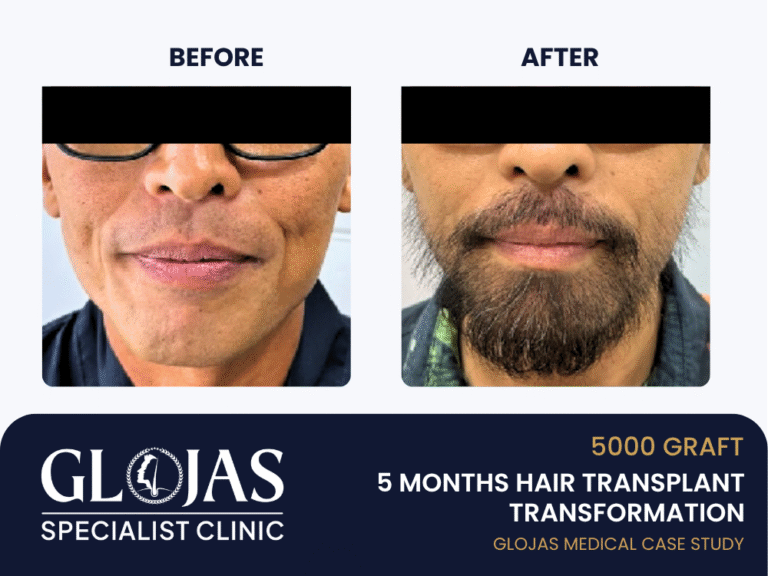Facial hair is more than just style — it’s a sign of maturity, masculinity, and confidence for many men. But for individuals with little to no beard growth, genetics often stands in the way of achieving their desired look. That was the case for a 31-year-old patient who sought a permanent solution for his nearly bare face.
This case study details his journey with a SMART™ FUE Beard Transplant, using 5,000 grafts to reconstruct an entirely new full beard. Just 4 months post-surgery, he’s already seeing visible progress.
Patient Profile
Age: 31
Issue: Minimal to no natural beard growth on cheeks, jawline, and chin
Skin Type: Type III, no keloid or scarring history
Beard Goals: Thick, well-contoured full beard with high cheek coverage and strong jawline framing
Donor Area: Scalp (occipital and parietal regions)
Why Choose SMART™ FUE for Beard Transplant?
SMART™ FUE (Scalp Micro-Advanced Restoration Technique) offers enhanced precision for facial hair transplants. Unlike traditional FUE, SMART™ FUE:
Utilizes micro-punch tools (0.6–0.8 mm) for minimal scarring
Ensures graft survival through advanced hydration and placement methods
Mimics natural beard angles for seamless blending
It is ideal for high-density facial transplants like this case
The goal was to build a beard from scratch with aesthetic balance and natural density.
Consultation & Design Strategy – Beard Transplant
During the consultation, the patient expressed a clear vision: a rugged, masculine beard covering the cheeks, jaw, chin, and moustache areas with a natural fade along the neckline.
Evaluation:
Sparse vellus hairs in the facial zone
Healthy, thick scalp donor hair
Strong jawline and bone structure suitable for a dense beard framing
Beard Design Objectives:
Create full coverage from sideburn to chin
Fill in the cheeks with moderate-to-high density
Define sharp jaw and neckline edges
Blend seamlessly with the upper lip and lower chin area
Procedure Overview

Technique: SMART™ FUE
Grafts Used: 5,000
Zones Treated: Cheeks, sideburns, jawline, chin, moustache, under lip
Session Duration: 9 hours total (single session)
Anesthesia: Local
Step-by-Step:
Donor area shaved and cleaned
Grafts harvested from the back of the scalp using micro-punch tools
Grafts sorted (1s, 2s, 3s) based on use – singles for beard edges, multiples for density
Recipient zones marked and anesthetized
Implanter pens are used for precision placement following natural hair angles
Post-op recovery began immediately with cooling, hydration, and aftercare guidance.
Post-Procedure Recovery

| Timeline | What Happened |
|---|---|
| Days 1–3 | Mild swelling on cheeks and chin, redness visible |
| Day 5–7 | Light scabbing over implanted areas |
| Week 2–3 | Shock loss phase: implanted hairs shed temporarily |
| Month 2 | Regrowth of fine new hairs begins |
| Month 4 | Visible shape and density developing, ~50–60% follicle activity |
At month 4, new growth has covered the once-smooth skin with texture, density, and definition. The full outline of the beard has formed, and more thickening is expected over the next 8 months.
4-Month Results

Even in the early stages of growth, the patient has a noticeable beard frame and more freedom to shape or groom.
| Before | 4 Months After |
|---|---|
| No beard on cheeks or jawline | Visible stubble and frame from sideburns |
| Sparse chin and moustache area | Moustache blends naturally with a beard |
| Smooth, hairless facial appearance | Stronger masculine facial features |
Patient Feedback
“I finally feel like I’m growing into the look I’ve always wanted. I used to envy guys with beards — now I’m one of them.”
Beard Aftercare Routine
No shaving or trimming for the first 4 weeks
Gentle face washing with antiseptic cleanser
Daily moisturizer for skin comfort
Avoid heat and direct sun exposure for 1 month
Optional PRP booster at months 3–6 for enhanced growth
5 Frequently Asked Questions (FAQ)
1. Is 5,000 grafts too many for a beard?
Not necessarily. Full beard reconstruction, especially for patients with no natural facial hair, can require 4,000–5,500 grafts for proper density and coverage.
2. When will I see the final result?
Beard transplant full results typically develop between 9 and 12 months. At 4 months, early growth and shaping begin, with major density filling in after month 6.
3. Does it hurt?
The procedure is performed under local anesthesia, so discomfort is minimal. Post-op, mild swelling and redness subside within a few days.
4. Will the beard hair feel natural?
Yes. The transplanted scalp hairs adapt to the beard zone over time, especially after the first full growth cycle. The texture becomes more coarse and beard-like.
5. Can I shape or trim the beard?
You can begin light trimming after month 2, and full grooming or styling after 3 months, depending on healing and growth.
🧾 Final Thoughts
This case illustrates how SMART™ FUE Beard Transplant can transform even the most sparse or non-existent facial hair into a natural, full-looking beard. With 5,000 grafts, artistic design, and precise execution, the patient achieved dramatic early results and is on track for a dense, masculine look.
If you’re considering building a beard where there was none, enhancing patchy growth, SMART™ FUE is a safe, minimally invasive, and permanent solution tailored to your facial structure and personal style.
